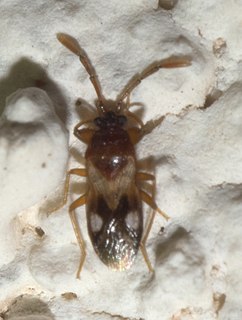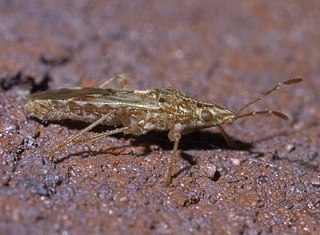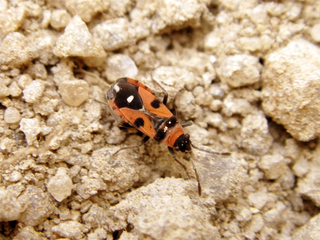
The Lygaeidae are a family in the Hemiptera, with more than 110 genera in four subfamilies. The family is commonly referred to as seed bugs, and less commonly, milkweed bugs, or ground bugs. However, while many of the species feed on seeds, some feed on sap (mucivory) or seed pods, others are omnivores and a few, such as the wekiu bug, are carnivores that feed exclusively on insects. Insects in this family are distributed across the world, including throughout North America. The family was vastly larger, but numerous former subfamilies have been removed and given independent family status, including the Artheneidae, Blissidae, Cryptorhamphidae, Cymidae, Geocoridae, Heterogastridae, Ninidae, Oxycarenidae and Rhyparochromidae, which together constituted well over half of the former family.

Leptoglossus is a genus of true bugs in the leaf-footed bug family and the tribe Anisoscelini. Species are distributed throughout the Americas, with some records in eastern & southern Asia and Europe. Several species are economic pests of agricultural crops. Like members of some other genera in the family, these bugs have leaflike dilations of the hind tibia. Several species are of economic importance, and one species, L. chilensis, has been reported to bite humans.

The Blissidae are a family in the Hemiptera, comprising nearly 50 genera and 400 species. The group has often been treated as a subfamily of the Lygaeidae but was resurrected as a full family by Thomas Henry (1997).

Neacoryphus is a genus of seed bugs in the family Lygaeidae. There are about five described species in Neacoryphus.

Ochrimnus is a genus of seed bugs in the family Lygaeidae. There are more than 40 described species in Ochrimnus.
Lygaeospilus is a genus of seed bugs in the family Lygaeidae. There are at least four described species in Lygaeospilus.

Kleidocerys is a genus of seed bugs in the family Lygaeidae. There are about 17 described species in Kleidocerys.
Hoplinus is a genus of stilt bugs in the family Berytidae. There are about six described species in Hoplinus.

Tempyra is a genus of dirt-colored seed bugs in the family Rhyparochromidae. There are at least two described species in Tempyra.

Oncopeltus is a genus of seed bugs in the family Lygaeidae, which has at least 40 described species in Oncopeltus.

Melanopleurus belfragei, the redcoat seed bug, is a species of seed bug in the family Lygaeidae. It is found in Central America and North America.

Xyonysius is a genus of seed bugs in the family Lygaeidae. There are about eight described species in Xyonysius.

Belonochilus is a genus of seed bugs in the family Lygaeidae. There is one described species in Belonochilus, B. numenius.

Malcidae is a family of true bugs in the order Hemiptera. There are at least 4 genera and more than 40 described species in Malcidae.

Ischnorhynchinae is a subfamily of seed bugs in the family Lygaeidae. There are about 16 genera and more than 70 described species in Ischnorhynchinae. The members of this subfamily are small, terrestrial insects that typically translucent or transparent plate-like structures covering the thorax (pronota) and tend to live in plant flowers.

Melanocoryphus is a genus of seed bugs in the family Lygaeidae. There are about eight described species in Melanocoryphus.

Melacoryphus is a genus of seed bugs in the family Lygaeidae. There are about 11 described species in Melacoryphus, found in Central and North America.

Horvathiolus is a genus of seed bugs in the family Lygaeidae. There are at least 20 described species in Horvathiolus.

Melanopleurus pyrrhopterus is a species of seed bug in the family Lygaeidae. It is found in the continental United States, Mexico, and has also been recorded in Canada.
















